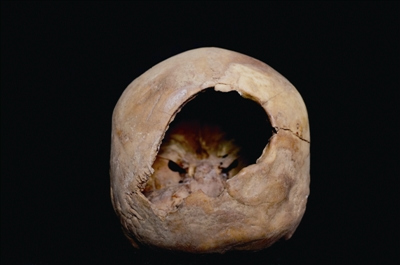

A perforated female skull discovered at the Xiaohe tomb complex.
A 3,500-year-old perforated female skull has been discovered at the Xiaohe tomb complex, which contained the largest number of mummies to have been found in the world, in northwest China's Xinjiang Uygur Autonomous Region.
Zhu Hong, an archaeologist with Jilin University, told an annual archaeological meeting over the weekend that the hole in the skull was about six centimeters in diameter, and there was evidence of healing tissues near the wound.
Scientists concluded that the modern practice of craniotomy, a surgical operation performed on the brain through an incision in the skull, may have been in use in China three centuries ago.
"[The wound] suggests that the female, who died in her 40s, must have lived for at least a month, or even longer, after receiving the surgery," Zhu said.
Last November, archaeologists identified China's oldest adhesive, in the form of gelatine, from a 3,500-year-old ritual staff in the same tomb.
The Xiaohe cemetery, 175 km west of the ancient city of Loulan, was first explored by Folke Bergman, a Swedish archaeologist in 1934. The massive burial site has over 300 graves and is known for its ship-shaped coffins.
Yuan Dynasty tombs unearthed in north China
2015-01-29Earliest musical instrument Se unearthed in central China
2015-01-06Stunning palace of Shang Dynasty unearthed in Henan
2015-01-05Colored pottery camel unearthed from Tang Dynasty tomb
2014-12-05Unearthed relics tell you the extravagant life of rulers
2014-11-27Copyright ©1999-2018
Chinanews.com. All rights reserved.
Reproduction in whole or in part without permission is prohibited.